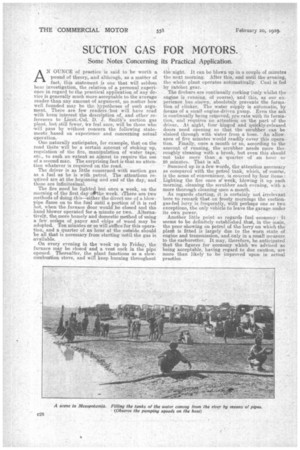SUCTION GAS FOR MOTORS.
Page 8

If you've noticed an error in this article please click here to report it so we can fix it.
. Some Notes Concerning its Practical Application. . Some Notes Concerning
AN OUNCE of practice is said to be worth a. 'pound of theory, and although, as a matter of fact, this statement is one that will seldom bear investigation, the relation of a personal experience in regard to the practical application of any device is generally much more acceptable to the average reader than any amount of argument, no matter how well founded may be the hypotheses of such argument. There are few readers ,but will have read with keen interest the description of, and otherreferences to Lieut.-Col. D. J. Smith's suction gas plant, but still fewer, ive feel sure, will be those who will pass by without concern the following statements based on experience and concerning actual operation. One naturally anticipates; for example, that on the road there will be a certain amount of stoking up, regulation of the fire, manipulation of water taps; etc., to such an extent as almost to require the use of a second man. The surprising fact is that no attention whatever is required on the road.
The driver is as little concerned with suction gas as a fuel as he is with petrol. The attentions required are at the beginning and end of the day, and these are infinitesiinal. •
The fire need be lighted but once a week, on the morning of the first day oflothe week. iThere are two methods of doing this—either the direct use of a blowpipe flame on to the fuel until a portion of it is red hot, when the furnace door would be closed and the hand blower operated for a minute or two. Alternatively, the more homely and domestic method of using a few sciaps of . paper and chips of wood may be adopted. Ten minutes or so will suffice for this operation, and a quarter of an hour at the outside should be all that is necessary from starting until the gas is available. .
On every evening in the week up to Friday, the furnace may be closed and a vent cock in the pipe opened. Thereafter, the plant functions as a slowcombustion stove, and will keep burning throughout
the night. it can be blown up in a couple of minutes the next morning. After this, and until the evening, the whole plant operates automatically. Coal is fed by 'ratchet gear.
The firebars are continually rocking (only whilst the engine is running, of course), and this, as our experience has shewn, absolutely prevents the formation of clinker, The water supply is automatic, by ineans of a small engine-driven pump. Even the as is continually being removed, Igo rata with its formation, and requires no attention on the part of the driver. At night, four hinged and quickly-released doors need opening so that the scrubber can be sluiced through with Water from a hose. An allowance of five minutes would readily cover this operation. Finally, once a month Or so, according to the amount of running, the scrubber needs more thoroughly cleaning with a brush, but even this should not take more than a quarter of an hour or 20 minutes. That is all.
Summed up in a few words' the attention necessary as compared with the petrol tank, which, of course, is the acme of convenience, is covered by four items: Lighting the fire once at week, blowing it up each morning, cleaning the scrubber each evening, with a more thorough cleaning once a month.
As regards starting, it is certainly not irrelevant here to remark that on fiosty mornings the suctiongas-fed lorry is frequently, with perhaps one or two exceptions, the only vehicle to leave the garage under its own power. Another little point as regards fuel economy: -It seems to be definitely established that, in the main, the poor showing on petrol ofthe lorry on which the plant is fitted is largely due to the worn state of engine and transmission, and only in a small measure to the carburetter. It may, therefore, be anticipated that the figures for economy which we advised as being acceptable, having regard to due caution, are more than likely to be improved upon in actual practice






















